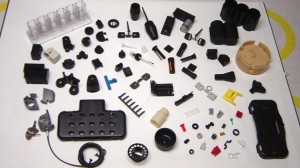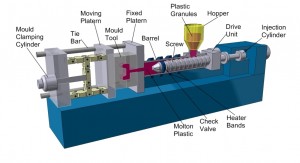9 Benefits of Plastic Injection Molding
Dec 6th 2023
In a previous article, we described the process of plastic injection molding, and listed some of their uses. In this article, we’ll review plastic injection molding’s advantages – and a few disadvantages. Here’s nine advantages, in no particular order of importance:

1. Plastic injection molding is extremely popular
Plastic Injection Molded Product Examples
Plastic injection molding is the most popular process in developing plastic parts, such as fasteners. Because of the processes’ popularity, there are many injection mold machine manufacturers, and repairs to a injection molding machine are relatively easy to come by.
2. Super flexible in design
Injection molded parts have an almost limitless amount of flexibility, no matter what the size of the produced parts.
Because injection molds are subjected to extremely high pressures, the plastic within the molds is pressed tighter that other molding processes. Also because of Computer aided design (CAD) and computer aided manufacturing (CAM), it is possible to include minute details and complex designs into the part’s design and to experience extremely tight tolerances as low as .001 in or more, depending on the type of plastic used.
3. High efficiency in mass production
While it takes a while to setup a machine – once the injection molds have been designed to specification and the presses have been programmed, the actual molding process is very fast compared to other molding methods. The plastic injection molding process can mass produce parts, all from a a single mold. The high production output rate of plastic injection molding allows it to be more cost effective and efficient.
How fast can each part be made? It depend on how many impressions (part molds) are in the tool, but typically cycle times can run between 15 and 30 seconds.
4. Significant strength enhancement
The plastic injection process offers a unique option within applications where parts need to be strong or durable. In plastic injection molding, it is possible to use fillers in the molds. What these fillers do is to reduce the plastic’s density while also adding greater strength to the molded part.
5. Allows the use of multiple plastic types, simultaneously
Through the process of co-injection molding, one major advantage of plastic injection molding is the ability to include different types of plastic simultaneously. Co-injection molding is the process of introducing two compatible materials into a single injection mold where the core material is completely encapsulated. The benefits of this process include allowing increased strength, reduced costs, and other potential beneficial properties such as reduced energy usage due to a secondary plastic’s reduced melting point.
6. Material and Color Flexibility
Image courtesy of Rutland Plastics
Once an injection mold is produced, the material and color of the part can be changed at any time.
7. Reduced Waste
Most plastics can be recycled, and the injection molding process allows for recycled plastics (through grinding it up and melting it all over again). Additionally, because of the high tolerances on part molds, there is less waste within the original manufacturing process.

8. Lower labor costs
Because the plastic injection molding is an automated process, a majority of the process is performed by machines, computers, and robotics – all of which a sole operator can control and manage. Automation helps to reduce manufacturing costs through this lower labor cost, thereby reducing overall overhead.
Additionally, post production labor work is typically minimal because the parts usually already a very finished look upon production.
9. Overall less expensive than plastic machining
Initially, a mold can be expensive to design and create – often at least a few thousand dollars, and it also takes time to develop a mold. However, besides the lower cost of labor, once a mold is created, you can mass produce a high volume of plastic components at a smaller cost. Some manufacturers suggest that with large production runs, using plastic injection molds can cost up to 25 times less than plastic machining

